Enterprise SATA SSDs: Can Budget 2020 beat Top Line 2017?
by Billy Tallis on February 4, 2020 11:00 AM ESTQD1 Random Read Performance
Drive throughput with a queue depth of one is usually not advertised, but almost every latency or consistency metric reported on a spec sheet is measured at QD1 and usually for 4kB transfers. When the drive only has one command to work on at a time, there's nothing to get in the way of it offering its best-case access latency. Performance at such light loads is absolutely not what most of these drives are made for, but they have to make it through the easy tests before we move on to the more realistic challenges.
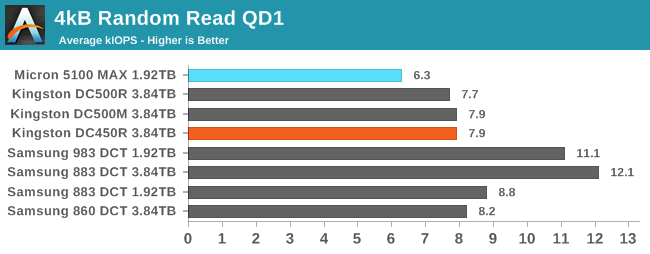
The Micron 5100 MAX has about 20% worse QD1 random read performance than the Kingston drives. This is primarily due to the underlying NAND: the 5100 MAX uses first-generation Intel/Micron 3D TLC, which was consistently slower than their newer 64L 3D NAND. But even the 64L Intel NAND used by Kingston's drives is still slower than Samsung's drives.
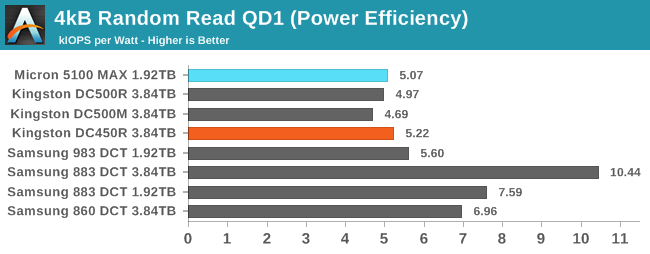 |
|||||||||
| Power Efficiency in kIOPS/W | Average Power in W | ||||||||
The Kingston DC450R uses a bit less power than the other two Kingston drives and thus ends up with the best efficiency rating among the three, but they're all considerably more power-hungry than the Samsung SATA drives. The Micron 5100 MAX uses only slightly more power than the Samsung SATA drives, but its lower performance leaves it with a similar efficiency score to the Kingston drives.
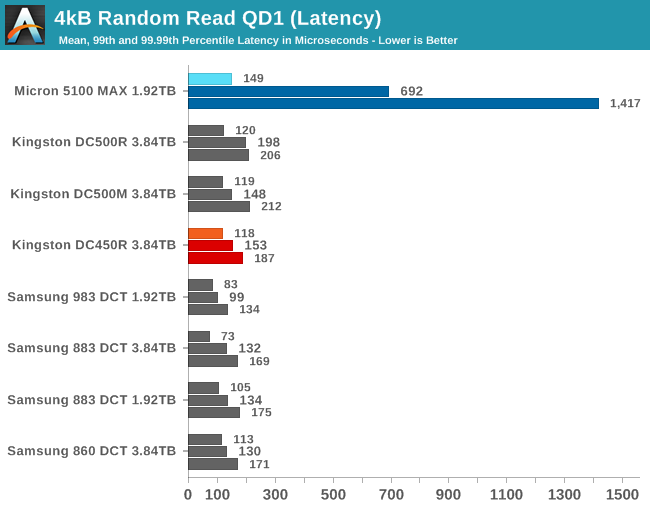
The Micron 5100 MAX stands out from the newer drives for having much worse tail latency scores, despite being a very high-end model. It's occasionally taking well over a millisecond to return data, which is surprisingly poor QoS for such a light workload. The Kingston DC450R fares similarly to the DC500s, with tail latencies that are only slightly higher than the average latency.
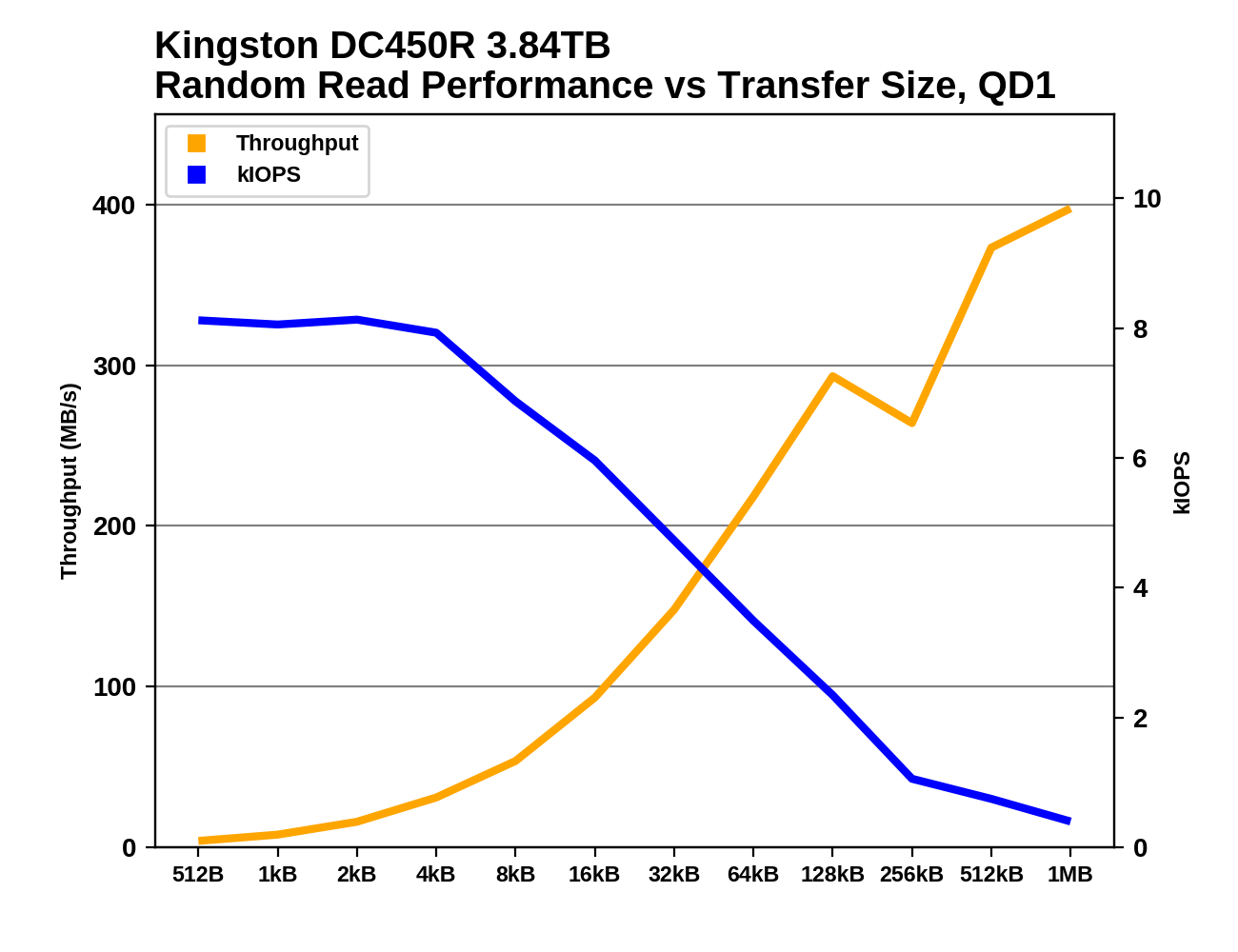 |
|||||||||
The Kingston DC450R and Micron 5100 MAX both show roughly constant IOPS for random reads up to 4kB in size, in line with the other Kingston drives rather than showing the peak at 4kB that the Samsung 883 gives. Beyond 128kB, the DC450R shows a more severe faltering in performance than most of the other SATA drives, while the Micron 5100 MAX simply shows performance that grows relatively slowly with transfer size.
QD1 Random Write Performance
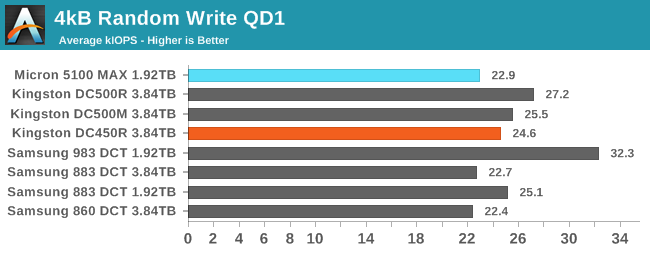
There's not much variation between the SATA drives for QD1 random write performance. All of these drives are capable of accepting a write command into their cache fairly quickly, and fully disguise the latency of actually writing to the flash.
 |
|||||||||
| Power Efficiency in kIOPS/W | Average Power in W | ||||||||
The Kingston DC450R's power draw during the QD1 random write test is quite high, second only to the DR500R—these drives are clearly busier in the background than the DC500M that has more spare area to work with. Those two drives end up with the worst efficiency scores by far for this test. The Micron 5100 MAX averages only 2W compared to over 5.5W, so it has a great efficiency score here.
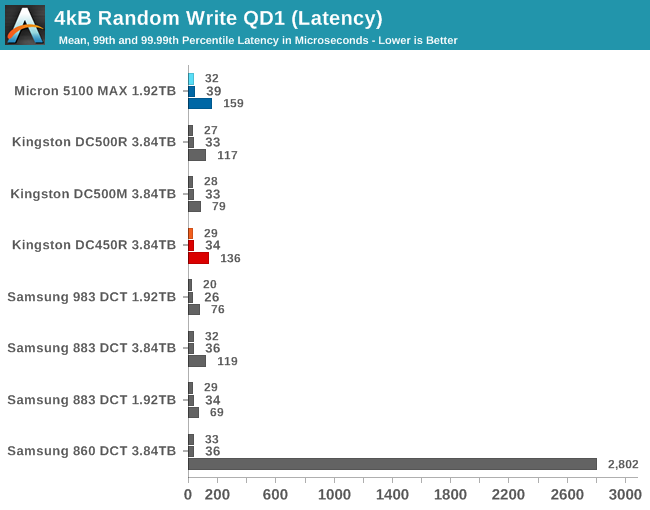
The Micron 5100 MAX and Kingston DC450R both have fairly typical latency scores for this test. Neither suffers from the stand-out tail latency problem the entry-level Samsung 860 DCT has.
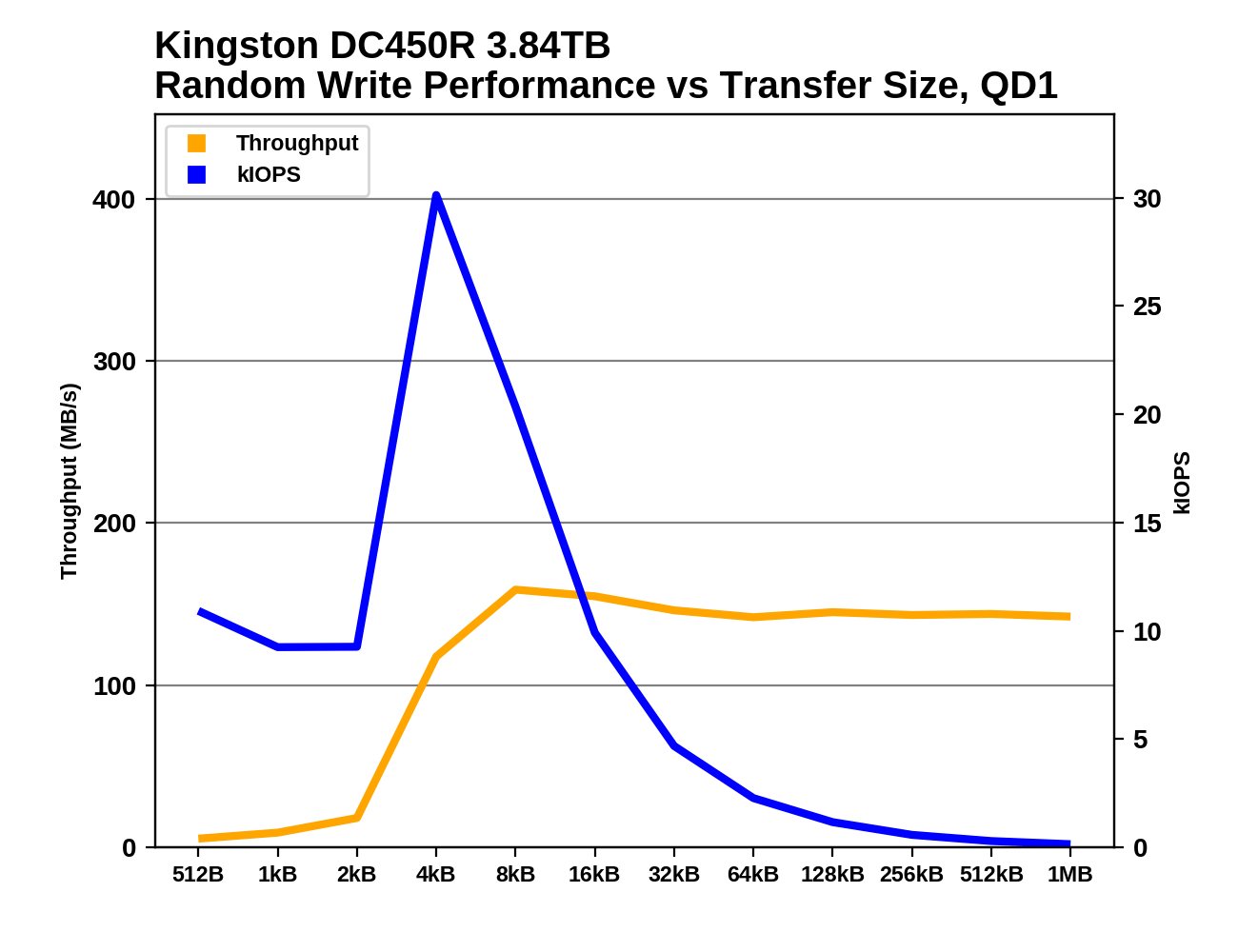 |
|||||||||
The Kingston DC450R didn't wasn't narrowly tuned for 4kB operations when it came to random reads, but for random writes it's definitely optimized for that one specific block size, and to a greater degree than the DC500R. The Micron drive also gives peak random write IOPS for 4kB block sizes, but handles everything from 512 bytes up to 8kB fairly well.
QD1 Sequential Read Performance
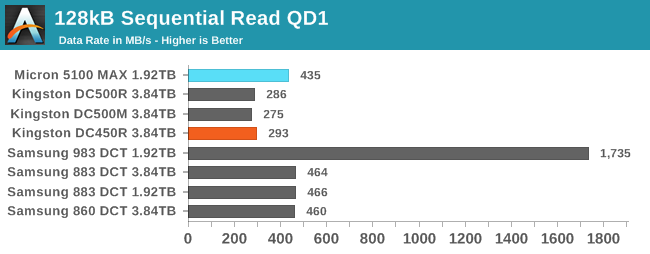
The Kingston DC450R continues the pattern set by the DC500 series of fairly low sequential read performance at QD1. The Micron 5100 MAX is only a bit slower than the Samsung drives on this test.
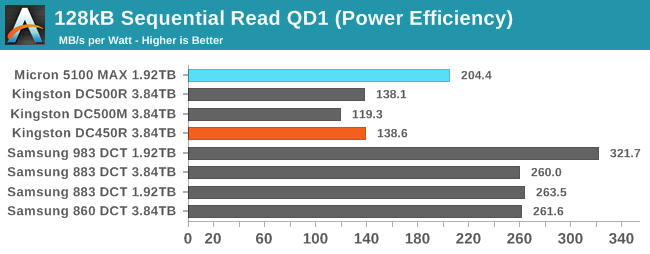 |
|||||||||
| Power Efficiency in MB/s/W | Average Power in W | ||||||||
The Kingston DC450R and Micron 5100 MAX both use about the same amount of power on this test, about 20% more than the Samsung drives. That leaves the Kingston drive with barely more than half the performance per Watt of Samsung's SATA drives, while the Micron has about three-quarters.
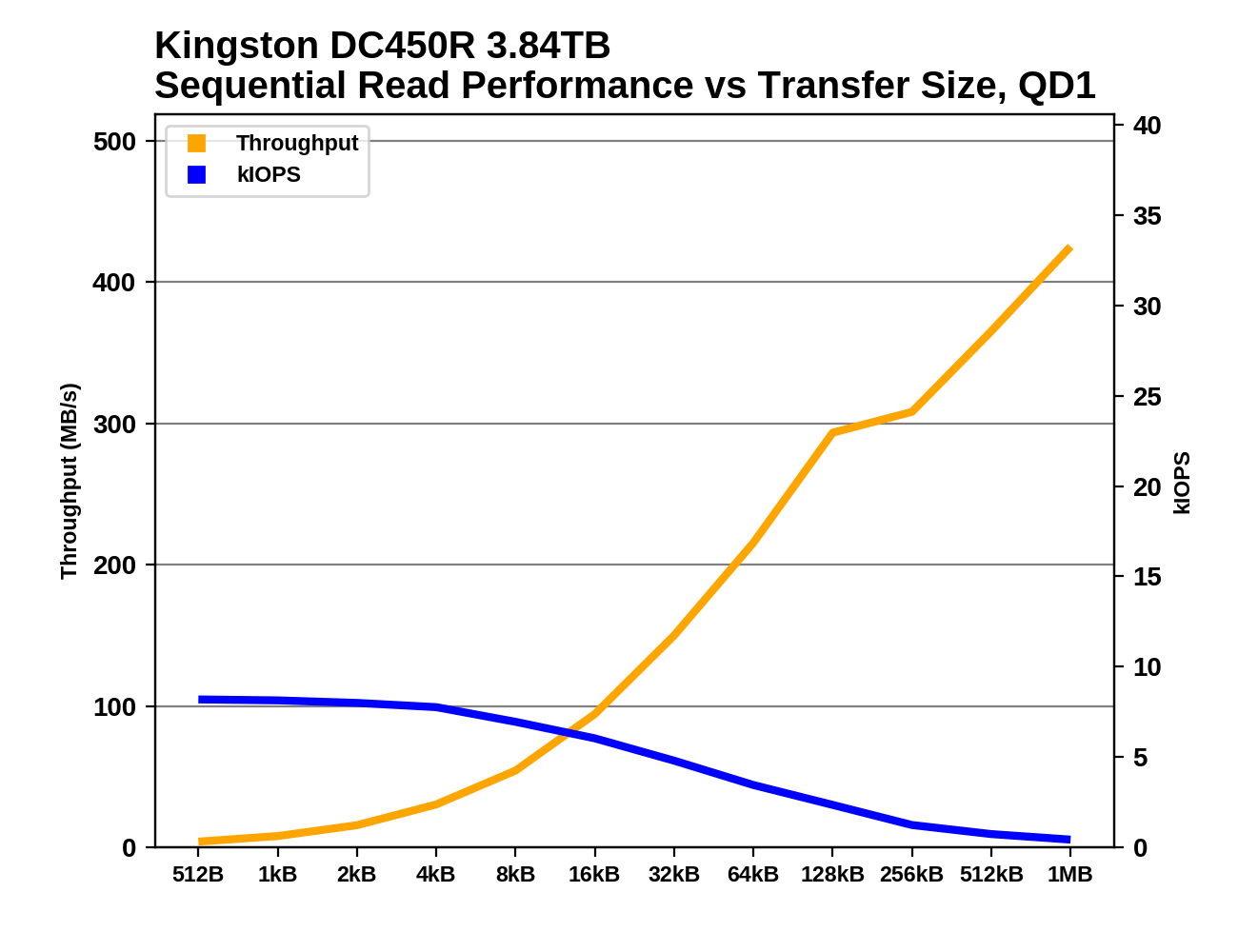 |
|||||||||
The Micron 5100 MAX provides full sequential read speed with block sizes of 128kB or larger, similar to the Samsung drives. The Kingston DC450R inherits the same behavior as the DC500 series, with sequential read performance that is still catching up as the block size grows up to a full 1MB.
QD1 Sequential Write Performance
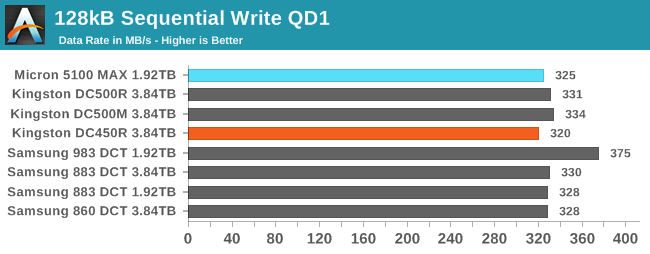
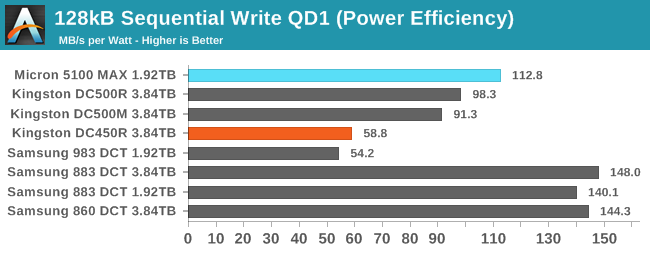 |
|||||||||
| Power Efficiency in MB/s/W | Average Power in W | ||||||||
These SATA drives all have about the same QD1 sequential write performance. The important differences show up when we look at the power meter. The Kingston DC450R is far and away the most power-hungry of the SATA drives, giving it a much worse efficiency score than even the DC500s. The Micron 5100 MAX offers almost twice the performance per Watt on this test, but the Samsung SATA drives still clearly lead the pack for efficiency.
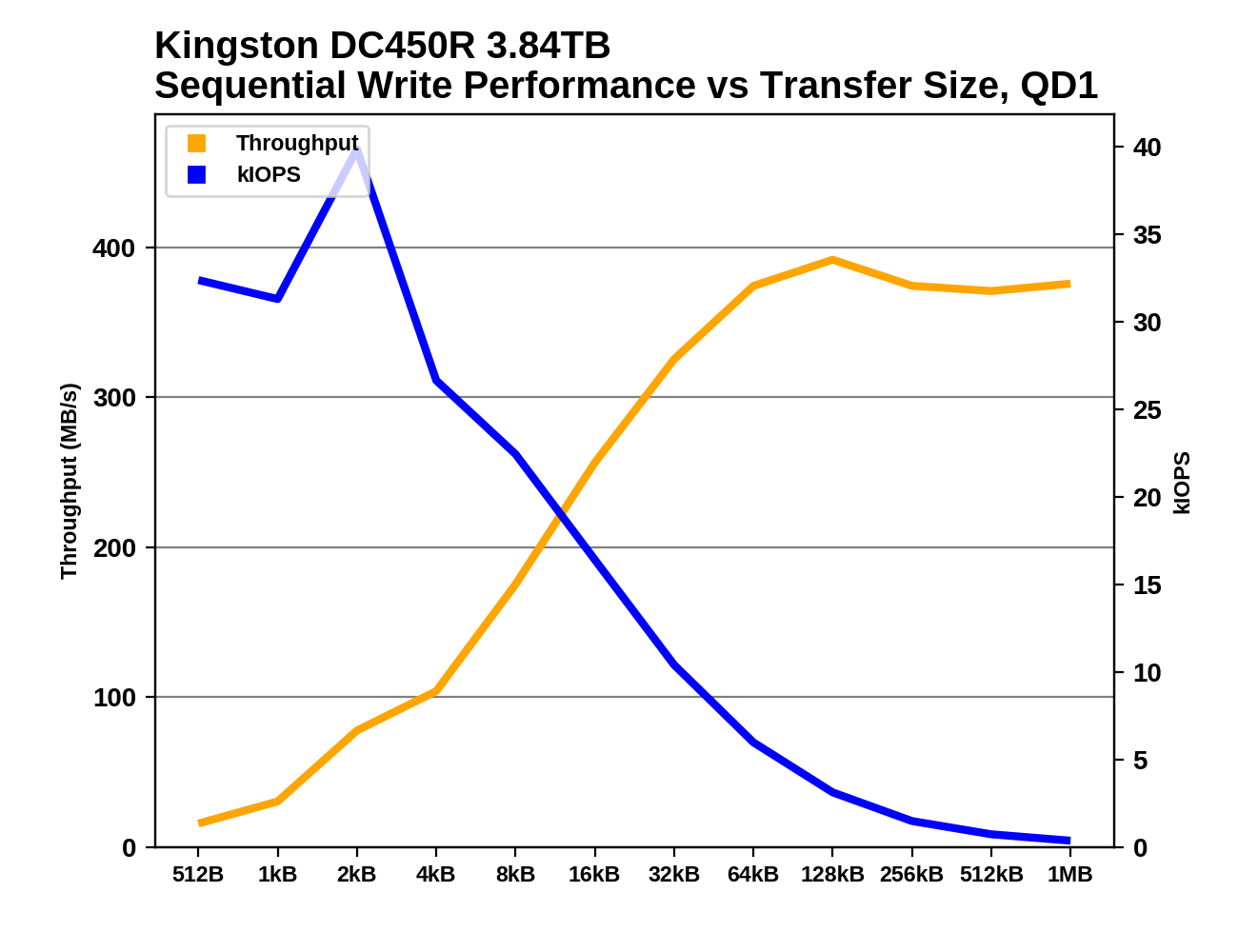 |
|||||||||
The Micron 5100 MAX shows remarkably poor sequential write performance for block sizes smaller than 4kB, but there's not much real-world relevance to that weakness. At larger block sizes of 128kB and up, all of these SATA drives are able to get reasonably close to the limits of their host interface—though the Kingston DC450R is still a little bit slower than the others.










20 Comments
View All Comments
romrunning - Tuesday, February 4, 2020 - link
I understand the reason (batch of excess drives leftover from OEM) for using the Micro 5100 MAX, but for "enterprise" SSD use, I really would have liked to see Intel's DC-series (DC = Data Center) of enterprise SSDs compared.DanNeely - Tuesday, February 4, 2020 - link
This is a new benchmark suite, which means all the drives Billy has will need to be re-ran through it to get fresh numbers which is why the comparison selection is so limited. More drives will come in as they're retested; but looking at the bench SSD 2018 data it looks like the only enterprise SSDs Intel has sampled are Optanes.Billy Tallis - Tuesday, February 4, 2020 - link
This review was specifically to get the SATA drives out of the way. I also have 9 new enterprise NVMe drives to be included in one or two upcoming reviews, and that's where I'll include the fresh results for drives I've already reviewed like the Intel P4510, Optane P4800X and Memblaze PBlaze5.I started benchmarking drives with the new test suite at the end of November, and kept the testbed busy around the clock until the day before I left for CES.
romrunning - Wednesday, February 5, 2020 - link
I appreciate getting more enterprise storage reviews! Not enough of them, especially for those times when you might have some leeway on which storage to choose.pandemonium - Wednesday, February 5, 2020 - link
Agreed. I'm curious how my old pseudo enterprise Intel 750 would compare here.Scipio Africanus - Tuesday, February 4, 2020 - link
I love those old stock enterprise drives. Before I went NVME just a few months ago, my primary drive was a Samsung SM863 960gb which was a pumped up high endrance 850 Pro.shodanshok - Wednesday, February 5, 2020 - link
Hi Billy, thank for the review. I always appreciate similar article.That said, this review really fails to take into account the true difference between the listed enterprise disks, and this is due to a general misunderstanding on what powerloss protection does and why it is important.
In the introduction, you state that powerloss protection is a data integrity features. While nominally true, the real added value of powerloss protection is much higher performance for synchronized write workloads (ie: SQL databases, filesystem metadata update, virtual machines, etc). Even disks *without* powerloss protection can give perfect data integrity: this is achieved with flush/fsync (on application/OS side) and SATA write barrier/FUAs. Applications which do not use fsync will be unreliable even on drive featuring powerloss protection, as any write will be cached in the OS cache for a relatively long time (~1s on Windows, ~30s on Linux), unless opening the file in direct/unbuffered mode.
Problem is, synchronous writes are *really* expensive and slow, even for flash-backed drive. I have the OEM version of a fast M.2 Samsung 960 EVO NVMe drive and in 4k sync writes it show only ~300 IOPs. For unsynched, direct writes (ie: bypassing OS cache but using its internal DRAM buffer), it has 1000x the IOPs. To be fast, flash really needs write coalescing. Avoiding that (via SATA flushes) really wreack havok on the drive performance.
Obviously, not all writes need to be synchronous: most use cases can tolerate a very low data loss window. However, for application were data integrity and durability are paramount (as SQL databases), sync writes are absolutely necessary. In these cases, powerloss protected SSD will have performance one (or more) order of magnitude higher than consumer disks: having a non-volatile DRAM cache (thank to power capacitors), they will simply *ignore* SATA flushes. This enable write aggregation/coalescing and the relative very high performance advantage.
In short: if faced with a SQL or VM workload, the Kingston DC450R will fare very poorly, while the Micron 5100 MAX (or even the DC500R) will be much faster. This is fine: the DC450R is a read-intensive drive, not intended for SQL workloads. However, this review (which put it against powerloss protected drives) fails to account for that key difference.
mgiammarco - Thursday, February 6, 2020 - link
I agree perfectly finally someone that explains the real importance of power loss protection. Frankly speaking an "enterprise ssd" without plp and with low write endurance is really should be called "enterprise"? Which is the difference with a standard sdd?AntonErtl - Wednesday, February 5, 2020 - link
There is a difference between data integrity and persistency, but power-loss protection is needed for either.Data integrity is when your data is not corrupted if the system fails, e.g., from a poweroff; this needs the software (in particular the data base system and/or file system) to request the writes in the right order), but it also needs the hardware to not reorder the writes, at least as far as the persistent state is concerned. Drives without power-loss protection tend not to give guarantees in this area; some guarantee that they will not damage data written long ago (which other drives may do when they consilidate the still-living data in an erase block), but that's not enough for data integrity.
Persistency is when the data is at least as up-to-date as when your last request for persistency (e.g., fsync) was completed. That's often needed in server applications; e.g., when a customer books something, the data should be in persistent storage before the server sends out the booking data to the customer.
shodanshok - Wednesday, February 5, 2020 - link
fsync(), write barrier and SATA flushes/FUAs put strong guarantee on data integrity and durability even *without* powerloss protected drive cache. So, even a "serious" database running on any reliable disk (ie: one not lying about flushes) will be 100% functional/safe; however, performance will tank.A drive with powerloss protected cache will give much higher performance but, if the application is correctly using fsync() and the OS supports write barrier, no added integrity/durability capability.
Regarding write reordering: write barrier explicitly avoid that.